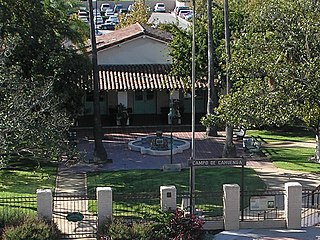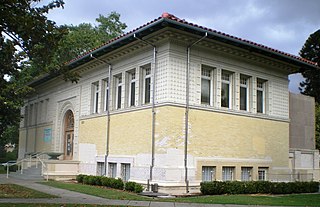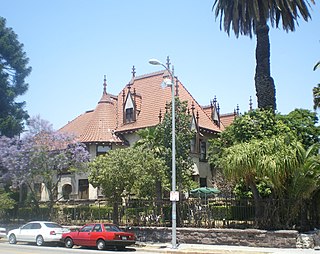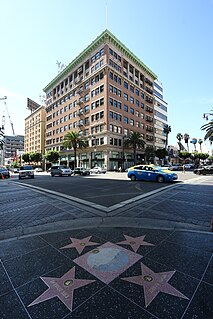
Eagle Rock is a neighborhood of Northeast Los Angeles, located between the cities of Glendale and Pasadena, abutting the San Rafael Hills in Los Angeles County, California. Eagle Rock is named after a large rock whose shadow resembles an eagle with its wings outstretched. Eagle Rock was once part of the Rancho San Rafael under Spanish and Mexican governorship. In 1911, Eagle Rock was incorporated as a city, and in 1923 it combined with the City of Los Angeles.

Vermont Square is a neighborhood in Los Angeles, California, within the South Los Angeles region. The Vermont Square Branch library, a designated Historic-Cultural Monument, is located in the community.

The Campo de Cahuenga, near the historic Cahuenga Pass in present-day Studio City, California, was an adobe ranch house on the Rancho Cahuenga where the Treaty of Cahuenga was signed between Lieutenant Colonel John C. Frémont and General Andrés Pico in 1847, ending hostilities in California between Mexico and the United States. The subsequent Treaty of Guadalupe Hidalgo of 1848, ceding California, parts of Colorado, Nevada, New Mexico, and Arizona to the United States, formally ended the Mexican–American War. From 1858 to 1861 the Campo de Cahuenga became a Butterfield Stage Station.

Second Church of Christ, Scientist is a historic former Christian Science church building located at 948 West Adams Boulevard, in the West Adams district of Los Angeles, California. It is now the Art of Living Center Los Angeles.

The Los Angeles Fire Department Museum and Memorial is located at Old Engine Co. No. 27, also known as Fire Station No. 27, on Cahuenga Boulevard in Hollywood. The museum houses old fire engines and fire apparatus, some dating from the 1880s. The museum also houses a reference library and fire safety learning center. The building was named a Los Angeles Cultural-Heritage Monument in 1976 and was listed in the National Register of Historic Places in 1985. The Fallen Firefighters Memorial in front of the station consists of a memorial wall listing all of the Los Angeles firefighters who have died in the line of duty and five life-size statues of firefighters.

Washington Irving Branch is a branch library of the Los Angeles Public Library, located west of downtown Los Angeles at 4117 West Washington Boulevard, Los Angeles.

Lincoln Heights Branch Library is the second oldest branch library in the Los Angeles Public Library system. Located in the Lincoln Heights section of Los Angeles, California, it was built in the Classical Revival and Italian Renaissance Revival styles in 1916 with a grant from Andrew Carnegie. One of three surviving Carnegie libraries in Los Angeles, it has been designated as a Historic-Cultural Monument and listed on the National Register of Historic Places.

Vermont Square Branch Library is the oldest branch library in the Los Angeles Public Library system. Located about a mile southwest of the University of Southern California campus, in the Vermont Square district, it was built in 1913 with a grant from Andrew Carnegie. One of three surviving Carnegie libraries in Los Angeles, it has been designated a Historic-Cultural Monument and listed on the National Register of Historic Places.

Cahuenga Branch is the third oldest branch library facility in the Los Angeles Public Library system. Located at 4591 Santa Monica Boulevard in the East Hollywood section of Los Angeles, it was built in 1916 with a grant from Andrew Carnegie. One of three surviving Carnegie libraries in Los Angeles, it has been designated as a Historic-Cultural Monument and listed in the National Register of Historic Places.

Van Nuys Branch covers two branch library buildings of the Los Angeles Public Library, both located in Van Nuys, central San Fernando Valley, Los Angeles, California.

Wilmington Branch is a branch library of the Los Angeles Public Library located in the Wilmington section of Los Angeles, California. It was built in 1927 based on a Spanish Colonial Revival design by architect W.E. McAllister.

Textile Center Building is a 12-story Gothic Revival and Italian Renaissance Revival architectural styled brick building located in the Los Angeles Fashion District. Designed by William Douglas Lee in the Gothic Revival style, the building opened in 1926 as a center for garment manufacturing. It has since been converted to condominiums.

Granada Shoppes and Studios, also known as the Granada Buildings, is an imaginative, Mediterranean Revival and Spanish Colonial Revival style block-long complex consisting of four courtyard-connected structures, in Central Los Angeles, California. It was built immediately to the southeast of Lafayette Park in the Westlake District, in 1927.

Whitley Court is a cluster of Spanish Colonial bungalows built from 1903 to 1919 just north of Hollywood Boulevard in Hollywood, Los Angeles, California.

Susana Machado Bernard House and Barn is an elaborate 10,000-square-foot (930 m2) Art Nouveau Gothic Revival style mansion and carriage house located in the Pico Union section of Los Angeles, California. Built in 1901, the house was designed by architect John B. Parkinson (1861–1935). Parkinson also designed the Los Angeles Memorial Coliseum, Union Station and Los Angeles City Hall. Noted for its Gothic style with soaring spaces, the house has vaulted ceilings and curved walls. In 1979, it was designated a Los Angeles Historic-Cultural Monument, and listed on the National Register of Historic Places. The property was purchased in 1996 by the Center for Human Rights & Constitutional Law. Since 2002, the house has been operated as the Casa Libre/Freedom House, a fourteen-bed shelter for homeless minors. In May 2003, the Los Angeles Times profiled the shelter, noting the following: "Casa Libre/Freedom House occupies a newly renovated mansion near MacArthur Park. Registered as a state, county and federal historic site, the home's gothic facade rises elegantly from the corner of South Lake Street and James M. Wood Boulevard. The shelter arranges for schooling, counseling, and medical care for undocumented and unaccompanied immigrant children, mainly from Latin America.

Ralphs Grocery Store is a historic building in the Westwood Village section of Westwood, Los Angeles, California. Built in 1929 as a Ralphs Grocery Store, it was one of the original six buildings in the Westwood Village development. The building was noted for its cylindrical rotunda capped by a low saucer dome, with a pediment over the entrance and arcaded wings extending north and east. It was photographed by Ansel Adams in 1940, declared a Historic-Cultural Monument in 1988, and listed on the National Register of Historic Places in 1992.

Angelus Funeral Home is a funeral home in South Los Angeles, California. It was listed as a Los Angeles Historic-Cultural Monument in 2006 and on the National Register of Historic Places in 2009. In 1925, Angelus Funeral Home was the first Black-owned business to be incorporated in California. The current building on Crenshaw Boulevard was designed by noted African-American architect Paul R. Williams in the Spanish Colonial and Georgian Revival styles and also includes Art Deco elements.

The Broadway Hollywood Building is a building in Los Angeles' Hollywood district. The building is situated in the Hollywood Walk of Fame monument area on the southwest corner of the intersection referred to as Hollywood and Vine, marking the intersection of Hollywood Boulevard and Vine Street. It was originally built as the B. H. Dyas Building in 1927. The Broadway Hollywood Building is referred to by both its main address of 6300 Hollywood Boulevard and its side address of 1645 Vine Street.


















